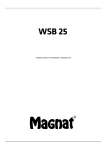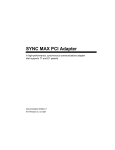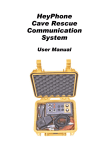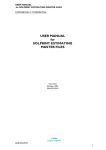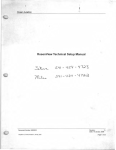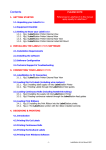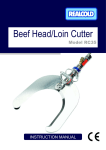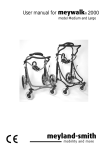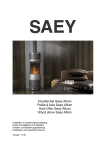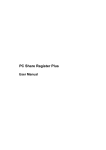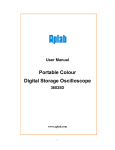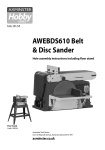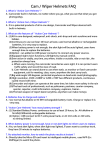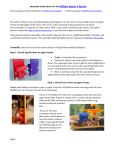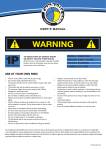Download BCRC HeyPhone – Physical Construction
Transcript
CAVE RADIO BCRC HeyPhone – Physical Construction Brian Jopling, “Jopo”, describes the mechanical design philosophy for the HeyPhone and gives some instruction for those intending to build a unit or to use similar techniques for other projects. Introduction The electronic design of the BCRC HeyPhone has already been published (Hey, 2000 & Bedford 2001). This article completes the public domain documentation by providing details of the mechanical construction. The information presented here serves three purposes: • It will provide the information necessary for servicing units. • It will enable rescue teams who need additional units after the end of the official BCRC production run is complete, to build units which are virtually identical to a genuine HeyPhone. • In providing details of the constructional techniques it will assist those building other cave-proof electronic equipment who are unable to find suitable enclosures. It is important that people intending to build a HeyPhone read a statement released by the BCRC which will be printed in the next issue. Overall Design The aim was to produce a box which: • was watertight; • separated the transceiver from the control box so that the damage-prone components such as switches could be replaced without interfering with the more delicate electronic circuitry; • could be fitted into a Peli 1200 case, Daren drum or a small ammo box. We could not find suitable commercial boxes and having custom made diecast boxes made was found to be very expensive given the quantities. Having spent some time prototyping, I decided that using gaskets and screw lids would be very difficult to achieve without sophisticated – and hence expensive – jigs for such a small run. It then occurred to me that if we bonded the separate parts together we would avoid gaskets and make the box less prone to inquisitive opening, but still reasonably easy to open for maintenance or repair. I chose PVC as it is nice to machine and easily solvent welded. Basically we have three components: 1. A top box for the controls, terminated at a D-type socket; 2. A top plate to carry a D-type plug to which the transceiver electronics is attached; 3. A bottom box. Effectively, the top plate forms the bottom of the top box and the top of the bottom box. Both boxes are basically a rectangular sheet “vee’d” along the fold lines, heatfolded, tack-bonded and a pillar fitted in each corner to give rigidity and a good corner seal. The pillars in the transceiver box are solid with those in the top box drilled as a screw guide (with an extra pair in the middle). The boxes are separated by a PVC plate which forms the barrier between the top (control) box and the bottom (transceiver) box and to which the control box is fitted. A waterproofed D-type socket in the plate connects the controls to the transceiver. On the underside of the plate are bonded six 4mm × 6mm∅ PVC buttons which are blind drilled and taped. The plate is kept level in the transceiver box by the corner pillars and four strips of PVC bonded onto the inside faces between the pillars. Tools & Materials The HeyPhone box has three components – a top (controls) box, the top plate to which the circuit boards are connected, and a bottom box to house the circuit boards. Side view (left) and top view (right). 4 I use mainly woodworking machine tools with tungsten cutters, as PVC soon dulls edges. The following tools and materials are required: BCRA CAVE RADIO & ELECTRONICS GROUP, JOURNAL 44, JUNE 2001 CAVE RADIO Tools • High speed table saw with a good fence; • Vertical Router table with fence; • Small high speed band saw with fence and stop; • Belt linisher with at least 250mm x 100mm flat face; • Small bench drill; • Small capstan lathe (metalworking); • Heat gun; • Cordless drill; • Drills and taps; • Various hand tools for dressing. Materials • Gap filling PVC solvent glue (PolyPipe GFC 100 or equivalent); • M3 x 30 round head machine screws; • 3mm PVC sheet and 6mm∅ PVC rod. Cutting & Bending Both boxes are made in the same way – only the dimensions change. Accuracy and consistency are vital or the bending and bonding to finished size will be a nightmare. 1. Sheets are cut to ±0.25 mm on the circular saw. A new blade gives excellent results. Guillotining is quicker but gives a rounded edge which is difficult to work to (keeps slipping under fences!). Both boxes are cut to give a box which is slightly too deep. This allows dressing to the finished depth when folded. It also ensures a good flat edge. 2. Four 90° “V” grooves are cut along the fold lines, to a depth of 2 – 2.2mm. I used a vertical-mounted router upside down with fence guide. Two cuts, roughing and finishing, are preferable as a better finish is achieved. The aim is to slightly over-bend as this then stops the box from wanting to open like a petal when bonding. Initially the folding was done over a former but, as long as your dimensions are accurate and you keep square, this proved to be unnecessary and time consuming – the depth of the “V” proved a good guide. The PVC is heated along the “V” and folded against a cold, flat surface as soon as it becomes plastic. The box is held in position until it cools (only a few seconds). Because we are not making watches, judging the squareness of the fold by eye is sufficient. 4. A bead of bond is applied all around the inner fold lines and up each side of the pillars. 5. When the boxes are dry the top open face is linished to size and de-frazed. 6. PVC dust is blown out. 7. The box is drilled to take the controls. 8. The controls and legend plate are fitted. 9. The controls are wired up and terminated with a 25-way D-type socket. 6. Tack-bond the corners. I use superglue to tack the corners. Initially I used a jig but found that it was easier to hand hold for the few seconds it takes to set. Attaching Pillars & Buttons I am fortunate in having a small capstan lathe which made the cutting and drilling of the pillars and the top plate buttons fairly swift. Machining these on a lathe would be extremely boring. Transceiver Box 1. A bead of solvent glue is applied to each corner of the tacked box and a solid pillar – 6mm∅ x 58mm PVC rod – is pressed into each. 2. When dry a good bead of glue is applied along the inside of the fold lines and then up each side of the pillars. This ensures a good strong watertight bond. Top Plate 1. The PVC sheet is cut to size. 2. The plate is jig-drilled M3 tapping size in six places. 3. A PVC button – 6mm∅ x 4mm PVC rod – is bonded onto the bottom surface of the top plate at each hole (a convenient tit is left when parting off to centre the button to the hole). 4. When dry, the holes are re-drilled M3 tapping size to a depth stop, giving a blind hole. 5. The holes are tapped M3. 3. Four strips of PVC (machined from offcuts) are then bonded between the pillars to form a ledge for the top plate. 3. The corner sections are cut out on a band saw with fence and stop. 6. The top edge of the plate is chamfered all round, on the linisher, to give a bond key. 4. All edges are dressed to remove fraze. 7. The 25-way D-type socket is attached to the plate and the transceiver electronics connecting via flying leads. Top Box 1. A hollow pillar – 6mm∅ x 25mm PVC rod, drilled 4mm∅ – is bonded into each corner as in the transceiver box. Unlike the transceiver box, glue is not applied to the fold lines at this stage. 2. The box is jig drilled in six places. 5. The folding is done using a heat gun, one seam at a time and the longer edges first. 3. A pair of hollow pillars – also 6mm∅ x 25mm PVC rod, drilled 4mm∅ – is tacked in place at the centre of each of the long edges. BCRA CAVE RADIO & ELECTRONICS GROUP, JOURNAL 44, JUNE 2001 Final Assembly Transceiver Box 1. The transceiver is attached to the top plate so care is taken not to strain any of the connecting wires. 5 CAVE RADIO 2. The unit is cantered on a sheet of 5mm neoprene and pushed carefully into the box. Using a wooden spatula, the corners of the neoprene sheet are tucked under the lid and the top plate located into position. Two light clamps are used to hold the top plate down as the neoprene sheet forms a good tight fit. 2. Remove the six screws and gently prise the top box off the plate. 3. The top plate is centred to give an even gap all round and a bead of solvent glue is applied. When the glue is dry (4 – 5 hours) the clamps are removed and the small gaps where the clamps fitted are filled. Fitting the Top Box to the Transceiver Box 1. The D-type socket connector in the top box has little movement, so care must be taken when fitting the socket into the corresponding D-type plug on the topplate (now bonded to the transceiver box) to avoid straining the wires. When the two are connected, the top box is aligned and six 3mm × 30mm M3 screws are fitted. I must admit that this sometimes takes a little fiddling. The boxes can bow a little and one has to use a little skill, and occasionally a little hole modifying, to locate the screws. Screw down evenly but don’t over tighten – remember that you are screwing into plastic. 2. At this stage the unit should be tested. Fit the microphone, power lead and battery, and two short antennas and switch on. I have a second set fired up and do a quick transceiver – receive test and check the LED and the volume control. Run the function knob through all positions. If all is OK you have fitted the plug to the socket correctly so you can finish off the assembly. 3. A bead of solvent glue is run all around the join between the top and bottom boxes to give a waterproof seal. At this stage you can check that the seal between the top plate and transceiver box is good. If you see any small air bubbles, cut them out with a sharp knife and re-fill. For cosmetic reasons I run a small bead of glue along the outside corner edges. Because each corner has a pillar bonded in, this is not really necessary – but it looks better. Separating for Maintenance or Repair Access can be gained to both the top box and the transceiver box. This should only be done if the unit has failed or you suspect that it has been flooded. Anyone who is competent with a soldering iron should be able to carry out repairs in the top-box. Faultfinding and repairing the main transceiver electronics, though, is more specialised. Unless the fault turns out to be something obvious like a broken wire, therefore, this will probably be beyond the capabilities of individual rescue teams. 3. Remember that the top box is still attached via the D-type plug and socket. Lift up the antenna socket end of the top box and carefully prise the plug from the socket with a flat blade screwdriver. 4. Lift the top box clear. Transceiver Box 1. Using care, cut vertically around the glue bead between the top plate and transceiver box. This bead is quite thick and you need to make sure you cut deep enough. Once the seal is broken all round, the top plate will lift off; but again remember that the transceiver unit is attached to the D-type plug. Carefully lift the unit and neoprene jacket out. Top Box 1. Using a sharp knife and some common sense, carefully cut horizontally around the glue bead between the top box and top plate. Be careful not to let the blade go under the box edge, and if you see red stuff you’re clumsy. 6 2. To re-fit, follow the procedures laid out in Final Assembly after cleaning the old glue from the edges. Before re-assembly make BCRA CAVE RADIO & ELECTRONICS GROUP, JOURNAL 44, JUNE 2001 CAVE RADIO sure there are no bits of glue or other debris to become trapped. Antennas Loop Antennas The HeyPhone has been designed to work both with loop antennas and earth antennas. However, only earth antennas are provided as standard. Loop antennas may be offered separately at a later stage or, failing this, constructional details will be provided. The main advantage of a loop antenna is a shorter set-up time but this is at the expense of performance. Earth antennas will nearly always provide a stronger signal and, therefore, a greater range so loops are only an attractive alternative in shallow caves. A surface set of electrodes consists of one or more heavy-duty tent pegs which are driven into the soil. Only two pegs are actually provided (one for the end of each piece of wire) and teams will have to determine whether this is adequate or whether additional pegs will be required. Generally, the greater the depth the more tent pegs will be required, but this is location dependent. When multiple pegs are in use, these must be connected together using short leads with crocodile clips on each end. Once again, teams will have to provide these if multiple pegs are needed. Multiple pegs must be separated by at least the length of the pegs – full installation instructions are provided in the HeyPhone User Manual. Earth Electrodes An earth antenna consists of two pieces of wire and two sets of earth electrodes. The earth electrodes are connected to the ground some distance apart with the HeyPhone halfway between them. They are connected to the HeyPhone using the two pieces of wire, each of which has a crocodile clip at one end for connecting to an electrode and a 4mm banana plug at the other end for connecting to the HeyPhone. lead, a microphone and the antennas, all of which are supplied with the HeyPhone. Note on Storage and General Handling I suggest that the HeyPhone container is left open when stored, provided that the store is dry. This will allow any moisture from usage to dry and prevent sweating. Operate the unit with clean hands whenever possible. Carrying a clean cloth inside a plastic bag along with the HeyPhone is a good idea for cleaning hands. Protect from rain or spray. If the antenna wires and earth electrodes are transported in the same box, they must be cleaned and dried before packing to move or wrap up. Mud or water will be transferred easily to the unit if simple precautions are not taken. I suggest that the antenna wires and earth electrodes are kept in a strong polythene bag. Provide some form of wipe or towel so the user can at least get the worst of the mud and water off. When carried in the container of choice, make sure that the unit cannot bang around inside. Use some form of non-absorbent material to protect it and always treat it like a piece of electronic equipment – which it is! Surface Earth Electrodes An underground earth electrode is a 20m length of electric fence tape. This is trailed in water or trodden into mud in order to provide as good an earth connection as possible. These electrodes would also be suitable for surface use – and will probably be more efficient than the intended surface electrodes – if there are pools or a stream at the surface location. Antenna Wires – Used with both Surface and Underground Earth Electrodes Two types of earth electrode are provided with each HeyPhone – one intended mainly for use on the surface and the other for underground use. It is recommended that both sets of electrodes are kept with each HeyPhone. All HeyPhone packages will, therefore, be identical so it won’t be possible to inadvertently take a HeyPhone underground which has been packed only with surface electrodes. The wires provided with the HeyPhone are each 25m long. If and when these wires need replacing, the exact specification is fairly non-critical. Thick wires are better, but only because they are less likely to get broken. Light coloured wires are easier to see underground. Underground Earth Electrodes Container The HeyPhone has been designed specifically to fit the Peli 1200 case, although it could be carried in any sufficiently large tough waterproof container. The Peli 1200 case is large enough to take the HeyPhone plus a 1.3Ah, 12V lead-acid battery, a power BCRA CAVE RADIO & ELECTRONICS GROUP, JOURNAL 44, JUNE 2001 References Bedford, Mike (2001) Update – HeyPhone Circuit, CREGJ 44, pp8, 12. Hey, John (2000) A New Rescue Radio – the Electronic Design, CREGJ 41, pp4-10. See also, Correction, CREGJ 44, p12. “The HeyPhone – a Statement by the BCRC,” will appear in the next issue. CREG 7




